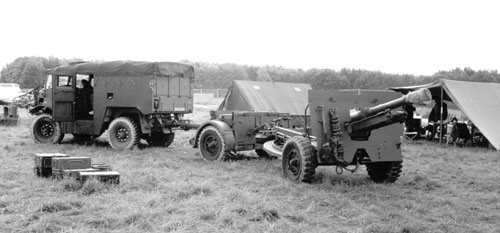 |
THE 25 POUNDER
The 25 -
pounder gun/howitzer was widely acclaimed as the best artillery weapon to
see action with any
unit during the Second World War.
This gun was the outcome of the experience of nearly 40 years of War &
peace. The lessons of the south african war
at the turn of the Century, led the british authorities to develop the 18
pounder gun and the 4.5 inch howitzer.
Both of which gave splendid service during the First world war but it was
decided to build a new gun which would be
capable of providing both the high angle fire of a howitzer and the flat trajectory
of a field gun.
theoretical studies indicated that such a gun should have a calibre in the
order of four inches and fire a shell
weighing about 30 pounds.
Economic restrictions resulted in the existing stock of 18 pounder's be relined.
Modern technology was possible
even then to carry out the required alterations. The original 25 ponders therefore
were in reality converted
18 pounder's on the same carriage.
the ballistic characteristics required for both the field and howitzer role,
meant that three different propellant
charges were required. This meant that different to the fixed ammo for the
18 pounder it now meant separate
shell and cartridge cases.
Experience also showed that the flexibility of the 25 pounder could be improved
if further choices were provided.
This was met by the introduction of two small propellant increments which
could be used to produce muzzle
velocities between those of the three main charges.
There was also an operational need to increase the maximum range beyond the
11,500 yds obtainable
with charge 3. To meet this a super charge was developed to give a range of
13,400 yards.
This charge naturally produced extra stress on the carriage and muzzle brakes
were introduced to relieve
this problem.
In addition to its function as both howitzer and field gun, the 25 pounder
was as lo a very potent anti-Tank gun.
To facilitate this function, advantage was taken of an invention which dated
back to the first World War.
a circular platform was carried below under the trail which could be dropped
onto the ground, allowing
rapid all round traverse for anti-Tank firing.
During the course of its service life the 25 pounder gun was mounted on numerous
designs of carriage.
Many of the converted 18 pounder's were lost at Dunkirk in 1940 and were replaced
with carriages
designed for the 25 pounder. The two best known were the Mark 4 & 5.
The former had two box shaped side brackets connected at front and rear, while
the latter had a split trail
which permitted extended traverse. The gun was as lo designed by the Canadians
to be carried on a sexton chassis,
this made it a very good self propelled gun and was well received by those
who used it.
Standard projectile HE shell Mk . ID S/L
Fuse No 117 or 119
Weight - 25 lbs
Range table ................Charge 1 : 650 ft per sec.
Muzzle Velocities........Charge 2 : 975 ft per sec.
......................................Charge 3 : 1,450 ft per sec.
Ordanance - steel : weight with Breech mechanism 8cwt . 3 qtrs (444 Kgs)
length : 96.72 inches
Calibre : 3.45 inches
Chamber capacity : 151 cu inches
polygroove rifling : 1 turn in 20 calibres (69 ins)
Manufacturer : ordanance
Country of origin : UK
Calibre : 3.45 inch (87.6mm)
Length (metres) : 2.4
Wheel Base width (metres) : 1.79
weight in action (Kg) : 1,800
Ammunition : 25lb (11.33Kg) shell. (HE - Armour piercing - shot - smoke -
illuminating)
Range (metres) : 12,253
Rate of Fire (rounds per minute) : 10
| Copyright © 2002, Chris
Dunham . All Rights Reserved |